As we head into a new year, we must always consider where we have been to know where we are going. Here at Connected World, in the month of December, we looked back to paint a picture of where we have been in the past year, in order to give us the foresight to know where we should be headed. Now, it is time to look to the year ahead.
The biggest questions swirling around for many are which technology will be the top ones to watch in the year ahead—and which ones will not. Perhaps this comes as no surprise, but AI (artificial intelligence) and ML (machine learning) top of the list of the hottest technologies expected for 2024.

Bloomberg suggests gen AI could grow to a $1.3 trillion opportunity in the next 10 years, as the market swells 42%. This is driven by the rapid advancement of technology and the needs of businesses, among a worker shortage, cost constraints, and the overall need for greater sustainability in the workplace.
The use cases and the opportunities that gen AI presents are perhaps the most interesting to consider here—but of course there is always more to consider too like quantum and cybersecurity. What else is interesting is what technologies will not take off in the year ahead. The answer just might help companies direct their energies elsewhere. We posed this very question to some industry leaders to find out what is coming in the year ahead.
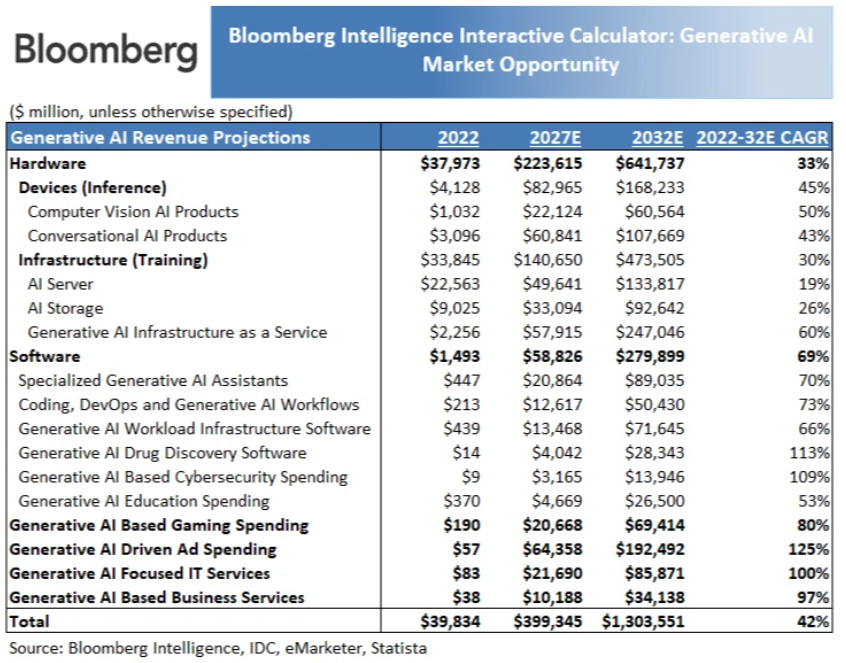
At the same time, we asked them for their advice on how companies can move forward, amid a worker shortage. Perhaps most interesting, we asked this panel the question: who the worker of tomorrow will be? The answer to this question, combined with what technologies to focus on, will catapult businesses into a better tomorrow. Finally, these visionaries helped identify how we can prepare this workforce for the next generation technologies that are coming.
As we head in 2024, we must prepare our workforce and we must be ready with technologies to enhance efficiencies, improve customer service, better sustainability, and create a better for tomorrow for all future generations. And this starts today.
What will be the top technologies to watch in the year ahead?
“Artificial intelligence and machine learning are expected to continue their growth in various sectors including healthcare, finance, and autonomous vehicles. Quantum computing is also gaining traction, potentially revolutionizing computation by solving complex problems that are currently infeasible. Additionally, advancements in 5G technology will likely pave the way for more connected devices and a push towards smart cities.” – Jan Miller, CTO of threat analysis, OPSWAT
“This one is obvious with the Apple Vision Pro and just how advanced it will be over predecessors, even if an early-generation device. Will the Apple fanboys jump on it? Will the price point matter? How quickly will Apple announce and launch a second-gen version, or a lower-priced version, as has been rumored. On a more-techy level, I am excited to see the progress in volumetric video capturing, which will allow everyone to take 3D pictures and videos, which will again simplify VR content production.” – Rolf Illenberger, CEO/co-founder, VRdirect
“I am keeping an eye on co-packaged optics, machine learning and quantum cyber security, the latter of which has the eye of many big figures in the U.S. government.” – Lawrence Gasman, president and founder, Inside Quantum Technology
“I think the top technology that everyone is currently talking about is AI. While AI has been embedded in technology solutions for quite some time, I think three specific use cases will see a significant rise in 2024.
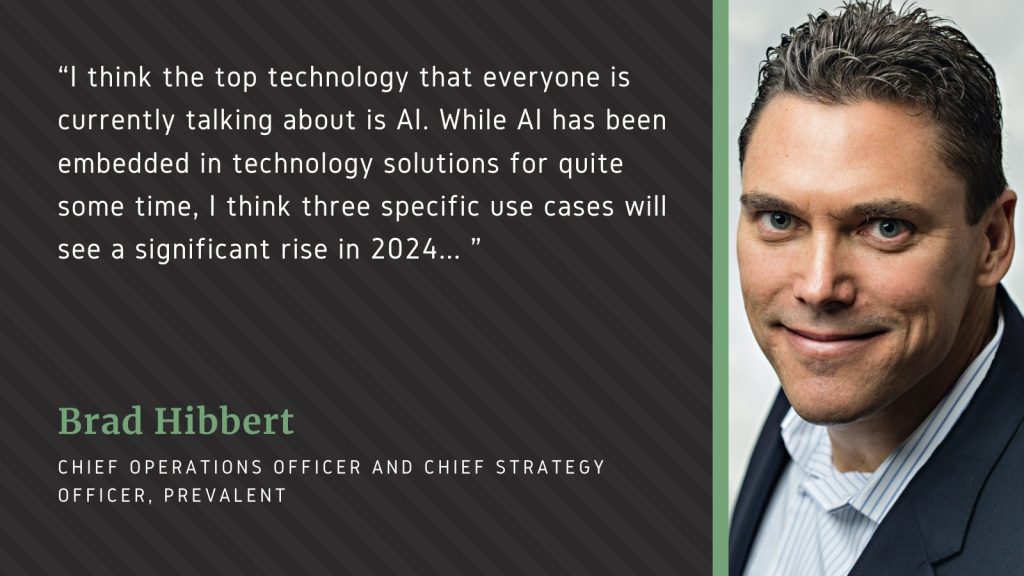
- The first is the use of LLMs to provide a more human interaction with solutions. Initially, it was used for educational and simplified data mining purposes, but gradually evolved into more complex automations, decision making and predictive analysis.
- With the explosion of unstructured data being used to support business operations including contracts, policy documents, regulations, security artifacts and more, the use of trained NLP to and ML models to rapidly review these files will also rise.
- The use of AI to help software developers accelerate and improve their coding with solutions such as Microsoft’s GitHub Copilot and AWS CodeWhisperer. Many organizations are piloting these solutions today and rolling them out over time. The ultimate goal of these tools is to make any developer, including a junior coder, an experienced professional to be more productive.”
– Brad Hibbert, chief operations officer and chief strategy officer, Prevalent
“The elephant in the room is generative AI. I am not suggesting that everything will be done with AI in 2024, but I believe that 2024 will be the year when enterprise technologies will recognize generative AI, at a minimum, and use it in some situations to everyone’s advantage.
From an identity security perspective, let’s look for technologies that deliver passwordless, or MFA that is more than a text or number. I am calling this “Multiple MFA”. As organizations work on implementing a Zero Trust architecture, MFA will become more than 2 or 3 factors. Instead, we should see a combination of:
- Something you know (less important now)
- Something you have (token, key, card, etc.)
- Something you are (biometrics, facial recognition, fingerprint, speech pattern, walking gait, etc.)
- Where you are (geolocation)
- Time (local, pre-approved times, or times in a given location)”
– Jeff Reich, executive director, Identity Defined Security Alliance (IDSA)

“The year ahead will see significant advancements in AI and machine learning for the construction industry, paving the way for more efficient, accurate, and cost-effective project management. IoT integration in construction equipment and wearables will enhance on-site safety and operational efficiency. We also expect a surge in building information modeling for more collaborative and sustainable construction projects. Cloud-based solutions will become more integral, offering seamless project management and real-time collaboration.
Advanced analytics tools can now sift through vast amounts of data to predict potential challenges and outcomes in construction projects. By analyzing past project data, these tools can forecast scheduling, budgeting, and resource allocation issues, enabling proactive planning.
AI algorithms in construction management solutions have become increasingly adept at accurately forecasting project timelines and costs. By considering variables such as workforce availability, material costs, and historical performance data, AI provides a more precise estimation, reducing the likelihood of costly overruns.
These tools will also help identify and assess risks in construction projects. By analyzing data from various sources, these systems can uncover hidden risk factors and suggest mitigation strategies, helping to avoid delays and cost overruns.
Construction technology tools will become even more crucial in minimizing errors and the need for rework in construction projects. By providing accurate data analysis and real-time feedback, these tools help make informed decisions, thereby reducing mistakes and subsequent rework costs.
Generative AI models will become the norm to simulate different construction scenarios and outcomes. This helps decision-making by providing insights on the most efficient methods, materials, and designs. AI algorithms can assist in optimal resource allocation, ensuring that manpower and materials are utilized effectively. AI can suggest the best allocation strategies to maximize efficiency by analyzing project requirements and timelines.
These technological advancements, particularly in AI and predictive analytics, are not just adding efficiency and accuracy to construction projects but open doors to new possibilities in how construction projects are planned, executed, and managed. As these technologies continue to evolve, they are set to redefine the standards and expectations in the construction industry.” – Shanthi Rajan, CEO, Linarc
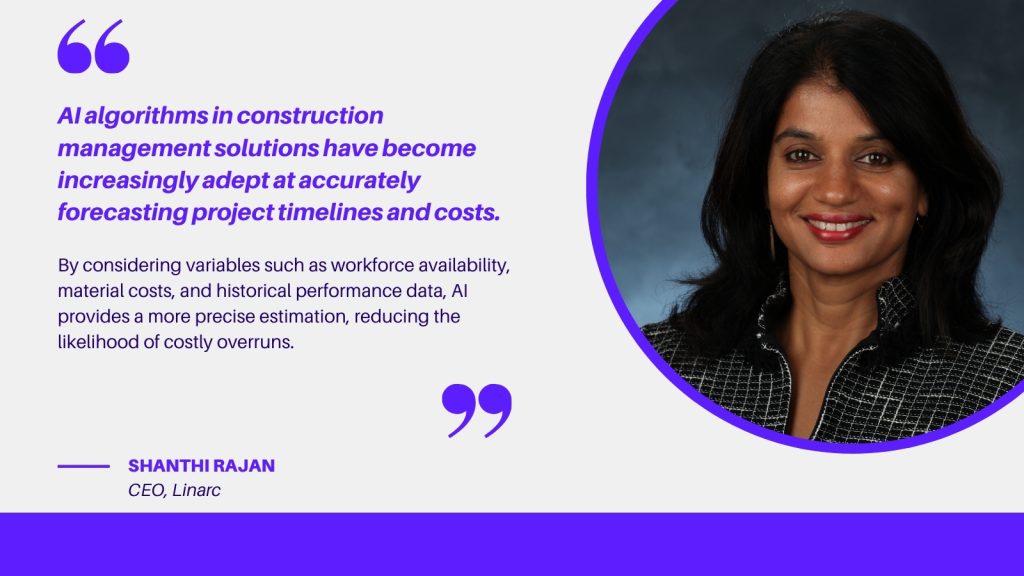
“The prominent technologies to monitor in the upcoming year will revolve primarily around various forms of artificial intelligence, or safeguarding the data that empowers it. Whether it involves leveraging AI for swift responses to business threats or employing novel tools to guard against AI data poisoning, AI stands at the forefront, capturing attention for its potential impact on all facets of society. Another noteworthy tech domain poised for significant growth is the API industry. The shift to the cloud has spurred unprecedented interconnectivity, largely driven by API technology. Lastly, continuous compliance monitoring is set to play a pivotal role in 2024. With a surge in regulations at global, national, and industry-specific levels, organizations will increasingly turn to automation to ascertain their adherence to the controls mandated by these regulations.” – Larry Whiteside Jr., CISO, RegScale
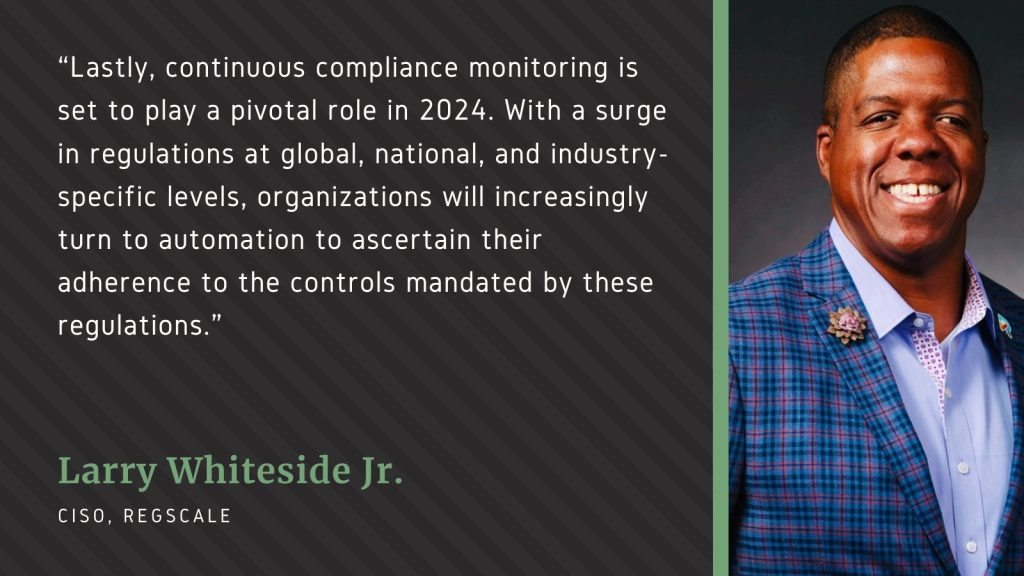
“As the NIS2 directive comes into effect in the EU in 2024, Member States must adopt and publish measures to comply with the NIS2 directive. As EU organizations take measures to comply, there will be an increase in cybersecurity spend as well as an acceleration in the adoption of data diodes, unidirectional gateways, threat prevention, and asset visibility technologies within critical infrastructure organizations.” – Mark Toussaint, sr. product manager, OPSWAT
“The focus on AI Trust, Risk, and Security Management (AI TRiSM), continuous threat exposure management, and sustainable technology underscores the importance of robust security frameworks in our increasingly digital world. These technologies are crucial for protecting data and ensuring business continuity. They emphasize the need for advanced security measures and compliance in a rapidly evolving digital landscape. This trend reflects a strategic shift towards prioritizing scalable and secure technological solutions. It’s essential for businesses to integrate these technologies into their operations to stay ahead.” – Igor Volovich, VP of compliance strategy, Qmulos
What technologies will not take off?
“While many technologies are emerging, some might not take off due to various reasons like lack of infrastructure, high costs, or limited practical applications. For example, while blockchain has potential, its application beyond cryptocurrencies, like in supply chain management, has seen slower adoption than anticipated.” – Jan Miller, CTO of threat analysis, OPSWAT
“It’s still too early for AR as a mass market device. Decisions by Meta, Pico, and Apple to develop VR devices with advanced video see-through technology will be the solution for the next 2 years until (optical see-through) AR is ready for mass market.” – Rolf Illenberger, CEO/co-founder, VRdirect
“I am very dubious about VR and the Metaverse.” – Lawrence Gasman, president and founder, Inside Quantum Technology
“AI CEO Humanoids 😉” – Brad Hibbert, chief operations officer and chief strategy officer, Prevalent
“Zero trust software: zero trust is a framework that needs to be designed to your specific needs. Buying a generic tool that claims to deliver zero trust should be given zero trust.” – Jeff Reich, executive director, Identity Defined Security Alliance (IDSA)
“The cybersecurity industry has experienced saturation in the endpoint security market. While I don’t foresee the introduction of new endpoint security tools, there is a likelihood of consolidation and the implementation of enhanced protection mechanisms at the endpoint.” – Larry Whiteside Jr. , CISO, RegScale
“Firewalls will retain their position and usefulness, but they will not ‘take off’.” – Mark Toussaint, sr. product manager, OPSWAT
“AR/VR and certain immersive technologies might face slower adoption due to complex integration challenges and the need for mature security protocols. This suggests a strategic focus on more practical, secure technologies. Businesses should prioritize innovations that offer stability and security in their application.” – Igor Volovich, VP of compliance strategy, Qmulos
How can companies prepare for the year ahead?
“Companies should focus on digital transformation, investing in cloud computing, and enhancing cybersecurity measures. Adopting a flexible and agile approach to technology implementation can also help businesses adapt to changes quickly.” – Jan Miller, CTO of threat analysis, OPSWAT
“2024 will be the year virtual reality is scaled across many companies and executives cannot afford to go into the new year without a VR strategy in place. This could start by targeting and trying different types of VR devices before greenlighting one standard model for company use, then establishing software solutions that allow the entire organization to take advantage of the new technology.
Also, worth watching and with the entire tech ecosystem in mind, the U.S. markets propped up Artificial Intelligence in 2023, while Meta’s share price has bounced back after a rocky 12-24 months. But how far does this extend to the rest of the tech landscape? Silicon Valley Bank’s collapse made it far more challenging for companies to acquire funding in 2023. Quite frankly, prepare for instability and be as adaptable as possible across your company and the tech landscape.” – Rolf Illenberger, CEO/co-founder, VRdirect
“Technology and related business processes have and will continue to evolve year after year. To stay relevant managers and executives must invest in themselves and their employees to perform continuous learning and skills development. This learning should include appropriate knowledge subscriptions and attendance at relevant industry webinars, conferences, and events to monitor trends and stay abreast of new technologies, opportunities, approaches, and threats that could impact your business.” – Brad Hibbert, chief operations officer and chief strategy officer, Prevalent
“Before you become the next headline, get back to basics. Truly identify every asset under your control. Be especially cognizant of any personal information along with your proprietary information. This data may be the right place to start your journey into zero trust. Regardless, up your game and the protection of those assets. Put the right controls in place then develop and test plans to respond quickly and correctly when the controls fail.” – Jeff Reich, executive director, Identity Defined Security Alliance (IDSA)
“To get ready for the upcoming year, companies should synchronize their technological requirements with two key aspects. Firstly, they must align their technology with their overall business strategy. Secondly, it’s crucial to align their cybersecurity strategy with the potential threats that could affect their business strategy. While this may seem straightforward at a surface level, delving into these components necessitates a prioritization based on risk. Following these fundamental steps will effectively mitigate a significant percentage of potential impacts on an organization.” – Larry Whiteside Jr. , CISO, RegScale
“Critical infrastructure organizations, especially those that deal with operational technology environments, can prepare for the year ahead by focusing on upskilling the ICS cybersecurity workforce, leveraging sector-specific threat intelligence, and alignment with industry frameworks.” – Mark Toussaint, sr. product manager, OPSWAT
“Companies must embrace technological integration and automation, focusing on scalable and secure solutions. Adapting to evolving cybersecurity threats and regulatory changes is crucial for resilience. This approach includes preparing for changes in the cybersecurity landscape. Ensuring business operations remain agile and compliant is key to success.” – Igor Volovich, VP of compliance strategy, Qmulos
Who will the worker of tomorrow be?
“The future worker will likely need to be highly adaptable, with skills in digital literacy, data analysis, and an understanding of AI and automation tools. Lifelong learning and upskilling will be critical as the pace of technological change continues to accelerate.” – Jan Miller, CTO of threat analysis, OPSWAT

“Though remote work was seen by many as a COVID fad, especially with major corporations desiring to return employees to the office, your worker of tomorrow will come from anywhere and be better prepared to tackle their jobs thanks to artificial intelligence and virtual reality [or metaverse technologies like VR, AR etc.].
The idea to simulate situations and to adapt scenarios for potential employees, literally, anywhere across the planet opens the talent market to new markets, and individuals. Yes, even those currently remote.” – Rolf Illenberger, CEO/co-founder, VRdirect
“From our experience we believe that AI will increasingly be used to automate repetitive and routine tasks. From a third-party risk management perspective, for example, this will include tasks such as populating assessments, analyzing results, and reviewing large volumes of documentation and data feeds. However, for the more complex critical thinking tasks that require higher level problem solving and peer consultation, humans will lead the charge, potentially augmented by AI.” – Brad Hibbert, chief operations officer and chief strategy officer, Prevalent
- “The worker of tomorrow will have a more diverse employment background – Digital Natives will rule the day.
- More fluid work environments will lead to greater creativity and productivity; management will finally begin to recognize that what you produce and when is more important than how.”
– Jeff Reich, executive director, Identity Defined Security Alliance (IDSA)
“The workforce of the future will undergo notable changes compared to the past decade. Not only is the workforce aging, but it’s also becoming more decentralized with remote work becoming increasingly prevalent. Both aspects bring both advantages and challenges. Regarding the aging workforce, the transition of individuals into cybersecurity from diverse career backgrounds introduces tech workers with broader mindsets shaped by experiences in other fields. However, questions arise about the potential impact on companies as the median age rises and individuals approach retirement. Concerning remote work, while there are evident threats to corporate data, there’s a positive side to it—remote employees often exhibit increased dedication and effort compared to their full-time office counterparts. This shift can result in enhanced efficiency and better outcomes for some organizations.” – Larry Whiteside Jr. , CISO, RegScale
“The cybersecurity professional of the future, particularly in the context of OT and critical infrastructure, will need to have a deep understanding of OT systems, knowledge of both OT and IT domains, and knowledge of regulatory compliance that enables them to think ahead of the curve and what’s to come.” – Mark Toussaint, sr. product manager, OPSWAT
“The future workforce will be more diverse and technologically adept, requiring an inclusive and digitally literate work environment. Continuous education and awareness around cybersecurity and data protection will be crucial. This shift calls for a culture that values ongoing learning and adaptation to new security challenges.” – Igor Volovich, VP of compliance strategy, Qmulos

How can we prepare our workforce for the next gen technologies that are coming?
“Organizations should invest in training programs to upskill their workforce. Partnerships with educational institutions to create tailored curriculums and offering in-house apprenticeships or continuous learning opportunities can be effective strategies.” – Jan Miller, CTO of threat analysis, OPSWAT
“In our world, we are prepared for HR departments to make significant investments in VR devices in 2024 and beyond. We’re not saying it’s the new laptop, but from a timesaving and efficiency standpoint, the ability to connect and train employees has never been easier, especially given advances in both VR and AI.
Preparing the workforce for this new technology is a key challenge for all employers, but the positive impact on the bottom-line finances and the ability to create realtime, adaptable simulations that are true-to-life, will motivate many to adapt. Getting employees in touch with these new technologies—especially VR—identifying compelling use cases, establishing a standardized tech infrastructure—hardware and software—across the organization is key for this.” – Rolf Illenberger, CEO/co-founder, VRdirect
“Trade schools and community colleges that focus on the practical aspects of AI and robotics are going to be big winners over the next few years. Even in an economy teetering on the brink of a recession, nearly every quantum company I know and work with is hiring.” – Lawrence Gasman, president and founder, Inside Quantum Technology

“Not only should organizations understand where AI best fits into their existing organizations, but they need to understand how AI can potentially change and improve their organization. This will include how AI will replace, change and/or augment existing business processes to improve business performance in future years. Once this is completed, organizations can then begin educating employees about the upcoming changes and benefits that AI will bring to build a culture of positivity and learning around the use of this new technology. Enable and challenge employees to participate by asking for help in identifying and prioritizing where and how AI automations can improve employee productivity and enable them to work on other more challenging and rewarding activities.” – Brad Hibbert, chief operations officer and chief strategy officer, Prevalent
“Traditional workers will need to immerse themselves in the new perspective and that includes new technologies—it’s not as simple as training traditional workers to adapt to new tools. We must all recognize that between the Internet of Things, artificial intelligence and privacy, many of the existing rules will start to fade” – Jeff Reich, executive director, Identity Defined Security Alliance (IDSA)
“Equipping the workforce for the upcoming wave of technologies hinges significantly on how an organization can effectively educate its employees and ensure they stay abreast of technological advancements evolving at the pace of business. This involves various approaches, and a company must determine its strategy before committing substantial investments to significant leaps in technological innovation that may affect its workforce.” – Larry Whiteside Jr., CISO, RegScale
“It’s essential to engrain a culture of cybersecurity within ICS environments through continuous cybersecurity improvements including:
- Up to date security documentation & policy – review security documentation and policies regularly and make sure they are comprehensively covered during onboarding and required parts of annual training.
- Training & awareness – Offer up-to-date access to adequate training and certification programs and ensure cybersecurity education is mandatory
- Conduct attack preparedness planning and simulation exercises.”
– Mark Toussaint, sr. product manager, OPSWAT
“Investing in employee development, especially in cybersecurity and compliance, is crucial for adapting to new technologies. This involves not only technical training but also fostering a mindset that values security. Understanding the importance of adhering to regulatory standards and best practices is essential. Companies should provide training opportunities that extend beyond technical skills. Creating a culture of continuous learning and adaptation is key to staying ahead in the technological landscape.” – Igor Volovich, VP of compliance strategy, Qmulos
What steps should businesses take?
“Businesses should stay informed about emerging technologies and begin pilot projects to understand their potential impact. They should also develop a technology strategy that aligns with their business goals and invest in a skilled workforce that can leverage new technologies effectively.” – Jan Miller, CTO of threat analysis, OPSWAT
“Jumping in and getting started, no matter how small.
That said, allocating budgets for VR projects, especially internal ones, are a good way to begin. Start building, recruiting, and retaining expertise and competencies in emerging technologies like Virtual Reality and Artificial Intelligence. Being able to have these internal evangelists teach and convert other employees and departments, leveraging not only how the technology works, but adding value through the process. The most important thing is making sure individuals at a given company are on top of new innovations and not left behind.” – Rolf Illenberger, CEO/co-founder, VRdirect

“There is a lot of information and higher expectations with respect to AI. First, a company needs to perform some education and research and get familiar with what AI can and cannot do. Next, a business can work with its managers and employees to identify what routine tasks and activities AI can solve. Recognize that your organization may not have an AI expert, so be open to bringing in outside expertise with experience with AI -focused business process optimization. Lastly, to demonstrate success and gain support for wider adoption, pick a few lower complexity activities to automate and pilot.” – Brad Hibbert, chief operations officer and chief strategy officer, Prevalent
“Businesses should be investing in a workforce that brings different perspectives – Having the right blend of generations, social backgrounds, work history, and knowledge of new technologies will get businesses ready for the future. Hire critical thinkers and listen to them.” – Jeff Reich, executive director, Identity Defined Security Alliance (IDSA)
“Present-day companies ought to critically assess their current employee education strategies and gauge their efficacy. Following this evaluation, they should implement the insights gained to chart their future course. This strategic decision could either propel them ahead, surpassing their competition, or lead them into the pitfalls of the innovation graveyard. Regardless of possessing cutting-edge technology, a business may falter if its workforce lacks the necessary capabilities to effectively utilize these advancements on a daily basis.” – Larry Whiteside Jr. , CISO, RegScale
“In addition to preparing the workforce, businesses should minimize their attack surface by implementing regular vulnerability assessments and bolster their asset visibility. Critical infrastructure, which is increasingly being targeted, should also prioritize securing data coming in and securing data out of their environments. This should entail deploying defense-in-depth media security, transient asset scanning and secure remote access solutions, as well as data diodes to ensure one-way transfers are enforced.” – Mark Toussaint, sr. product manager, OPSWAT
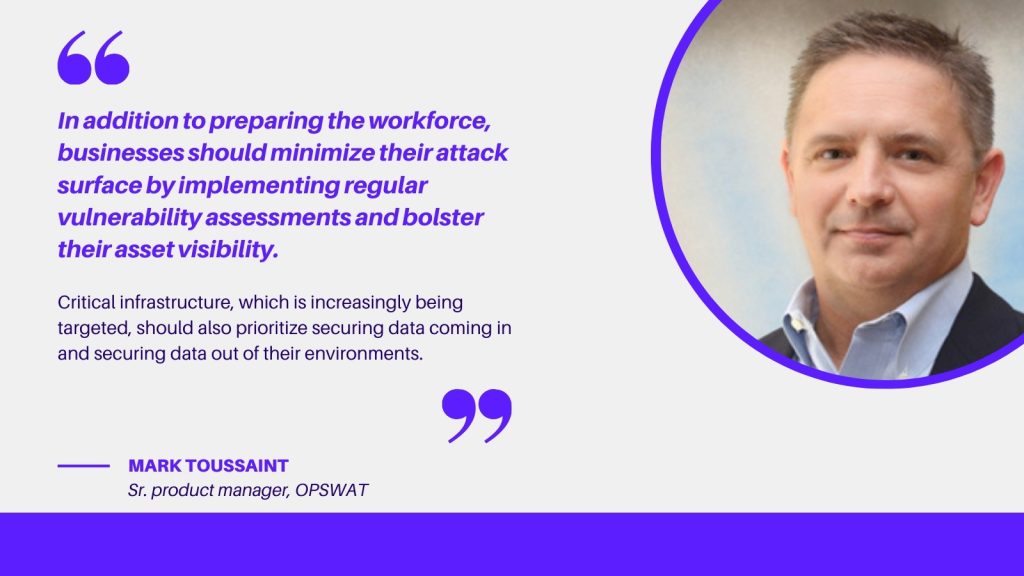
“Understanding the evolving landscape of cybersecurity threats and regulatory requirements is crucial. Integrating these considerations into business strategies ensures robust, compliant, and secure operations. Investing into continuous risk monitoring and mitigation capabilities leads a path to proactive, provable risk management practices. This strategic planning is vital for maintaining resilience in a rapidly changing digital world.” – Igor Volovich, VP of compliance strategy, Qmulos


